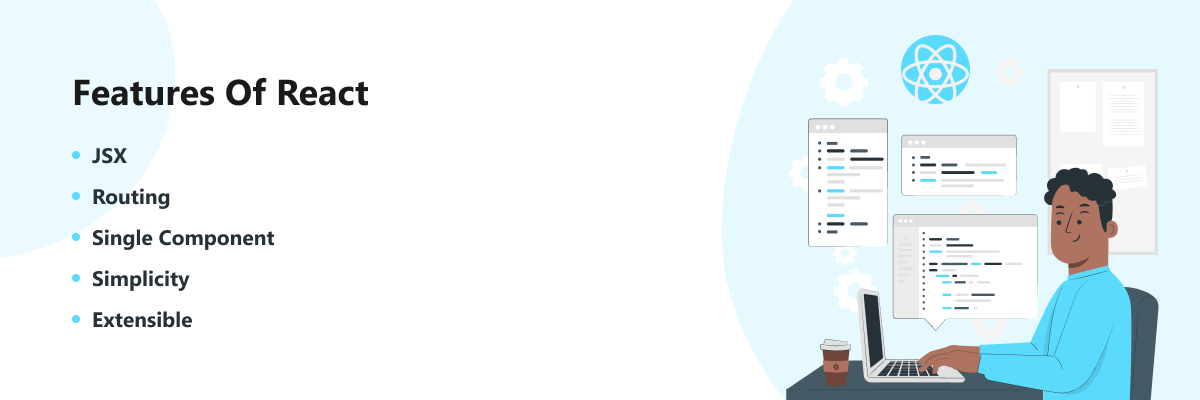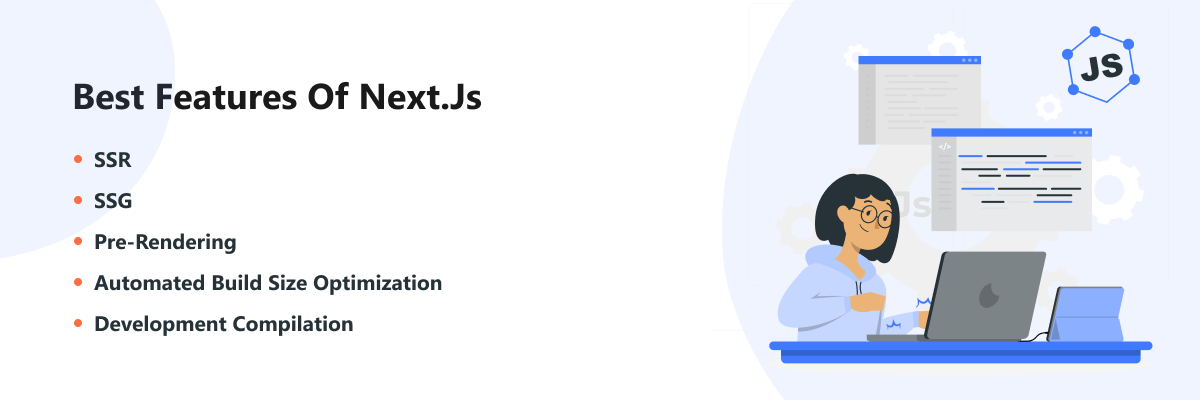One of the critical factors to consider before building a software project is, which framework to choose. Many developers choose the platform based on convenience and their skills.
But before choosing the platform, along with developers’ convenience, you also have to look into the project requirements.
React is one of the most popular frontend developing frameworks, and Next.js is one of the steadily growing platforms of the future.
React, and Next.js have the same ultimate goal, but both differ in their characters.
Here’s a detailed comparison of Next.js and React to help you choose the best front end platform for your next software project.
To know more about Next.js vs React, read on.
What is React?
React was introduced by Facebook in 2013. Since its release, it has become one of the most used front end libraries.
React is used to create a highly interactive user interface. React is mainly used to develop web apps that need constant updates, like Facebook or Instagram.
Usually, the entire website will be reloaded when you click on something on the web page. While using React, you can create single, isolated and reusable components. The whole website is not required to load every time you click on a component, such as liking a post, commenting etc.
React is used along with React Native and Redux to build complex UI interfaces.
React is utilised to develop web apps, single-page apps, dashboards, visualisation tools, and mobile apps.
What is Next.js?
Next.js is the React framework created by Vercel, which needs minimum or zero configuration. And it is now popular among the developer communities for its flexible features.
It is an open-source based on Node.js and Babel, and it integrates with React to develop single-page applications. It allows you to create hybrid pages with static and server-side rendered pages.
Next.js is used to create websites that are faster to upload and more SEO friendly. Most use cases will be static pages, e-commerce stores, landing pages and more.
Next.js works on the top of the React, along with Node.js, and it makes developing static or hybrid websites more effortless than ever.
Next.js vs. React
Using React or Next.js for your project has both ups and downs. But both make software development easier and more comfortable.
Let’s compare React and Next.js to better understand their performance.
1. Speed and easiness of coding
When you create a page using React, you need to create a component and then add it to the router.
But in the case of Next.js, you can create a page and add it to the page folder. Then you just need to add the component header link. This makes the life of the developer easy with minimal coding and configuration. Plus, it helps you develop products faster.
2. Features

Some important features of React are:
- JSX
- Single Component
- One-way Data Binding
- Virtual DOM
- More Simplicity
- Enhanced Performance
- Easily extensible
- Routing
- Management patterns

On the other hand, Next.js has improved features as it works on top of React such as:
- Server-side Rendering (SSR)
- Static export (SSG)
- Pre-rendering of the web pages
- Automated build size optimisation
- Improved development compilation
3. Documentation
Documentation is one of the most talked-about topics when comparing React and Next.js. Many home pages from the frameworks will be attractive, but you need some guidance like tutorials, books, articles, and courses to understand and implement them better.
There are many tutorials available on the internet for both Next.js and React. This documentation will help you find the complete and easy functionality of the tools.
Next.js has a “learn-by-doing” documentation set that leads you with things like directing and easy component creation. React also has the same setup, with a few exercises to help with the basics.
Understand their official documentation to get better high-level knowledge about React and Next.js.
4. Performance
Performance is one of the critical differences between next.js vs react.
Due to the features like server-side rendering, image optimisation and static destinations, the performance of websites developed with Next.js is better than React.
React websites are not highly performable due to some missing abilities compared to Next.js. React supports client-side rendering, which is unsuitable for SEO and has comparatively slower loading times.
If you choose Next.js, you can get advantages like code-splitting and automatic server-side rendering leading to a high-performance site.
5. Configuration
Another important difference between React and Next.js is configuration.
React is not easy when it comes to configuration. Until disconnected from the Create React App, setups won’t get changed. You will be using that in setup or configured in CRA read scripts.
On the other hand, Next.js has minimum configuration due to its server-side rendering. Next.js template allows you to configure using babelrc, jest.config, eslintrc etc.
6. Server-side rendering
Next.js supports server-side rendering. Next.js fetches data and renders it every time a request arises.
However, React doesn’t support server-side rendering. But it is possible to configure SSR into it, but it demands extra steps to set up.
7. Maintenance
Both React and Next.js have been very well maintained. There will be frequent updates and improved versions coming out from time to time. You just have to be aware of the releases for better updation and maintenance.
8. Typescript
React supports the CRA app with typescript with the help of ‘npx create-react-app my-app –template typescript’.
Next.js also supports typescripts and configurations with touch tsconfig.json.
9. Talent pool
React has been in the industry for some good time. So finding talent will be easy when compared to Next.js.
When you hire React developers, look for people with javascript knowledge. Likewise, while looking for Next.js developers, pick well-versed developers in React.
The talent pool is big for React and narrow for Next.js as the latter is emerging for now.
But looking into the future, you may find both the React and Next.js experts in the software industry in plenty due to the adaptability of the technology.
10. Community
Community is one important thing to consider before choosing the framework.
Developers’ community helps when you are stuck in between. React has an extensive developers community.
The community is active in providing solutions like blogs, tutorials, videos, and more. You can find a separate developer community on Stack Overflow.
Next.js has a good number of developer communities on Github. Even though it is emerging, you will find good help on Github.
Overall, both React, and Next.js have active developers’ communities.
11. Cost of development
Both React and Next.js are open sources, which means they are free to use. So the development cost will be low in both cases.
But an issue you will face is finding the perfect developers for your project. React has a large talent pool, and Next.js is narrower.
12. Easiness to learn
To write clean codes and utilise the tools in the frameworks or library, the developer needs to learn them better.
React is easy to learn, and it has a large community to support.
Next.js is also easy but requires some basic knowledge. Even the beginners in frontend development will find it less challenging to learn Next.js.
Next.js vs React – Overview
| React | Next.js | |
| Speed and easiness of coding | Fast coding | Fast coding |
| Feature | Easily extensible, Routing, Management pattern | Static export, Pre-rendering, Automatic optimisation |
| Documentation | Excellently written | Excellently written |
| Performance | Relabtabely low-performance | High-performance |
| Configuration | Not much room for configuration | Good configuration |
| Server-side rendering | No server-side rendering is provided out of the box. | Supports server-side rendering |
| Maintenance | Easy maintenance | Easy maintenance |
| Typescript | Have support | Have support |
| Talent pool | Broad | Narrow |
| Community | Large | Emerging |
| Cost of development | Less | Less |
| Easiness to learn | Easy | Easy |
Pros and Cons of React
Every development framework has its pros and cons. And React is no different.
| Pros | Cons |
|---|---|
| Easy development | Higher development rate – Needed constant relearning for developers |
| Huge developers community | Need for other sets of technology for completing the project |
| Improved productivity | |
| Enhanced customisation | |
| Reusable components | |
| Optimisable for SEO with some extra effort |
Pros and Cons of Next.js
| Pros | Cons |
|---|---|
| Develop faster websites | Next.js is used with the file router. You can’t change its working way. |
| More SEO friendly | Less community support |
| Simple development with less coding | |
| API routes accessibility | |
| Improved user experience | |
| Image optimisation | |
| Easy deployment |
Best Use Cases of React
- Data visualisation
- Cross-platform apps
Real use cases
- Airbnb
- Dropbox
- Tesla
- Netflix
- Newyork times
- BBC
Best Use Cases of Next.js
- Hulu
- Twitch
- Netflix jobs
- Nike
- Ticket master
- Audible
- Lego
- Trip.com
Real use cases
- E-commerce stores
- Dashboards
- Customer portal
- Marketing websites
- Single page applications
Conclusion
Before choosing the framework or library, consider which suits best for both the projects and the developers. Developers usually choose a convenient, performant, and seamless framework.
Both React and Next.js provide a lot of freedom to developers to experiment with new features. React has more extensive resources, and Next.js comes with turbo-filled features.
Find an energetic team to build your project the way you want it. If you find it difficult, many product development companies like NeoITO can help you develop your product using the right framework or library based on your requirements.




